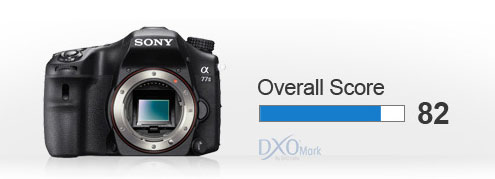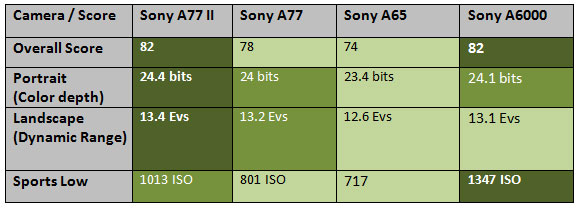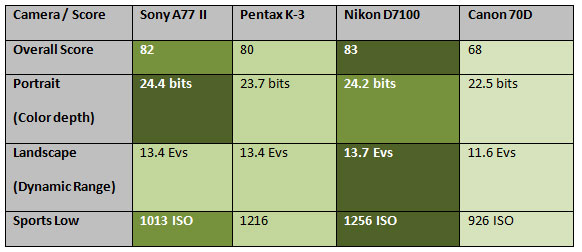
Sony A77 II score surfaced at DxOMark lab, the overall sensor performance is much improved when we compare the score of A77 II with A77 and other mirrorless and SLT cameras
 Sony A77 II versus popular DSLRs
Sony A77 II versus popular DSLRs
 src-DXOMARK
src-DXOMARK
|
|||||
|
Sony A77 II score surfaced at DxOMark lab, the overall sensor performance is much improved when we compare the score of A77 II with A77 and other mirrorless and SLT cameras
Both camera features excellent core specification and shares same APS-C sensor format, the price of both the camera are exactly the same… take a look at the specification comparison review and see who wins…
Image Stabilization : No matter what type of lenses you use, the A77 II offers in body image stabilization, The Nikon D7100 don’t have in body image stabilization, you have to buy VR lenses to fight camera shake. Low-pass filter: Without low-pass filter the Nikon D7100 will sure give you more details in images compared to A77 II. (when viewed at 100%). AF System: Technically the Sony A77 II does fast Auto focus since the camera is made with SLT technology, the A77 II uses phase and contrast based system at the same time and uses a total of 79 AF points to quickly acquire the focus, on the other hand the Nikon D7100 uses phase AF system with 51 AF point and contrast based system becomes active when you are using LCD live-view display for shooting your images. Continuous shooting: Without losing a fraction of second the A77 II shoots blazing fast continuous shots @ 12 fps and Nikon D7100 limited to 6fps. Display: With A77 II you get Swivel LCD display on the other hand Nikon D7100 comes with fixed LCD display. Connectivity: The A77 II features WiFi connectivity with NFC (near field communication), you cam share your images witlessly to your network and you can also use your smartphone or tablet to shoot images from a distance. No such facility available in Nikon D7100. Verdict: The Sony A77 II is a clear winner and a excellent camera based on specification comparison review, but with Nikon D7100 we get a huge amount of high quality lenses to choose from… and without optical low-filter we will get super sharp images when viewed at 100%. Buy A77 II from Amazon || B&H || Adorama |||| Buy Nikon D7100 from Amazon | B&H
STAY WITH ON FACEBOOK | TWITTER | GOOGLE+ || See more Nikon rumors || Sony Rumor. src-SAR.com
The RX100M3 is a successor of RX100 M2 camera, take a look below the table to see the major difference…
Sensor: Sony RX100M3 uses same sensor of RX100 M2 camera, but the image processor and the lens is new (mentioned below) so we may see some improvement in image quality. Image processor: The BionzX image processor of RX100 M3 camera is approx three times faster than the Bionz image processor of RX100 M2 camera, the image processor is responsible for decoding RAW files to JPEG, AF speed, shutter lag and fast image processor naturally boost the overall operational speed of the camera. Lenses: The lens losses some optical reach, Sony RX100 M3 able to do 2.9X optical zoom only and Sony RX100 M2 is able to do 3.6X optical zoom. Video: The frame rate remains same but new XAVC S recording format added (same as Sony A7s camera), audio recording format also get a facelift by adding Linear PCM (Pulse-code modulation – 2 channel). Introduction of OLED pop-up viewfinder: The 0.39″ 1,440k-dot SVGA OLED Tru-Finder EVF added by Sony in RX100 M3 camera, the EVF’s optics feature a Zeiss T* anti-reflective coating to enhance visibility, the viewfinder also features eye sensor to detect your eye position. The Hot-shoe is removed by Sony, it may bring disappointment to professional photographers since now there is no option left to use external flash or micro-phone. Verdict: The RX100 M3 does have improved lens, new image processor, pop-up viewfinder and highest level of (XAVC S) video recording format available, but the sensor remains same as RX100 M2 camera, the RX100 M2 users may wait (if you feel these improvements are not enough for you) for Sony RX100 M4 camera but for new users we highly recommend you to buy Sony RX100 M3.
Sony RX100 M3 Sample Images Surfaced over the web today, the low light samples have very less noise and the portrait sample (above) showing excellent background blur / bokeh like a professional DSLR. RX100 M3 is really one of the best ultra compact camera available in the market today…. see the announcement page here – Sony RX100 M3 Price, Press Release, Full Specification and Videos
SRC – Sony Global The long rumored Sony RX100 M3 camera finally announced today by Sony, the camera specification is similar to the specification we have published few days ago and even price is also same,
The RX100 M3 camera features same sensor as RX100 M2 camera but the lens is more improved and becomes more wider, this time we have Zeiss Vario-Sonnar T* f/1.8-2.8 Lens, the other major improvement is 3X fast BionzX image processor used in the new RX100 M3 camera.
The RX100 M3 camera now comes with a built-in 1.4M-dot OLED pop-up “Tru-Finder.” for professional users, the camera also records Full HD 1920 x 1080 videos and now movies can be recorded in the high-quality XAVC S format, which uses MPEG-4 AVC/H.264 video compression and linear PCM audio compression. You also get WiFi and NFC connectivity with RX100 M3. MSRP Price – $798.00 Press Release Sony RX100 M3Press Release
Sony Adds New Pocket-Sized RX100 III Camera to Acclaimed Cyber-shot® RX Line New RX100 III Model Features Large-Aperture ZEISS® 24-70mm lens1, Built-in OLED Viewfinder with ZEISS T* Coating, BIONZ® X processor and more SAN DIEGO, May 15, 2014 – Building on its lineup of acclaimed compact cameras, Sony Electronics has introduced a new addition to its popular Cyber-shot RX series – the pocket-sized RX100 III camera. “Sony continues to push the modern limits of engineering and innovation with our Cyber-shot RX family of products” said Patrick Huang, director of the Cyber-shot business at Sony Electronics. “With the new RX100 III model, we’ve added a brighter, wider aperture lens and an impressive retractable OLED EVF, while also utilizing the latest Sony imaging technologies to boost the camera’s processing speed and efficiency. And we’ve done this without sacrificing any of the true ‘pocketability’ of our RX100 line, creating an especially unique compact camera unlike anything else in market today.” New ZEISS® Vario-Sonnar T* 24-70mm1 F1.8-F2.8 Lens The versatile new lens is capable of capturing dramatic landscapes or large group photos at the wide 24mm length while also boasting impressive macro shooting capabilities throughout the focal range. For example, it can still focus accurately as close as 30cm from the front of the lens (working distance) when fully extended. There’s also a built-in 3-stop (1/8) neutral density filter that adds to shooting flexibility in a wide range of outdoor conditions. The new ZEISS lens realizes outstanding corner-to-corner sharpness, with nine total aspherical glass elements including two advanced aspherical elements that have been cemented together – a world’s first in lens manufaturing2. This results in an ultra-compact physical footprint while maintaining a wide maximum angle of view. Additionally, the 24-70mm lens1 features ZEISS T* coating that minimizes flare and ghosting and a seven-blade circular aperture that enhances ‘bokeh’ background defocus. Clear, High-Precision Built-in EVF with ZEISS T* Coating The unique new EVF also features a specially-designed eyepiece lens with ZEISS T* coating, dramatically reducing reflections that can interfere with clear viewing. The viewfinder achieves exceptional corner-to-corner clarity, and includes an eye sensor that automatically switches between viewfinder and monitor display. Exmor R CMOS Sensor and BIONZ X Processor The high-resolution sensor is paired with the evolved BIONZ X image processor introduced in the α7, α7R models this past fall. Around three times faster than the BIONZ processing engine in the RX100 and RX100 II models, it employs detail reproduction, diffraction-reducing and area-specific noise reduction technologies that allow the camera to produce amazingly detailed images and Full HD videos in all types of lighting conditions. Pro-Quality Full HD Video Capture The new compact is the first Cyber-shot model to offer high-resolution HD video recording in the XAVC S format, which allows for full HD recording at a data rate of 50 mbps with lower compression for improved video quality. Additionally, with the power of the BIONZ X processor, the camera is able to read, process and output data from all of the sensor’s pixels during video recording, ensuring that it produces the highest quality video possible by eliminating aliasing, moiré and false color artifacts. Other video features include a ‘clear’ HDMI® output for reviewing footage on an external monitor, 120 fps recording at 720p HD resolution and zebra pattering on the LCD and built-in EVF. The camera also has dual video recording capability (XAVC S / AVCHD files4 along with MP4 files), which allows users to shoot a high bit-rate video for storage or editing purposes while also recording a lower bit rate video that’s optimized for sharing via Wi-Fi®. The camera also has Intelligent Active Mode – another first for Cyber-shot RX series cameras – which utilizes Sony’s frame analysis technology and 5-axis compensation to dramatically reduce the effects of camera shake while shooting movies. Camera Design, Customizability and Control New to the RX series, the RX100 III model features an articulated LCD that can tilt upward by about 180 degrees for self-portraits and all the way downward to approximately 45 degrees for high-angle shots. The camera also can output still images in 4K resolution6 with full wide-gamut TRILUMINOUS Color support when connected to compatible 4K televisions. Wi-Fi® and PlayMemories™ For devices without NFC one-touch capabilities, users can wirelessly transfer images and videos and activate Smart Remote Control through Sony’s free PlayMemories Mobile™ application, available for the iOS and Android platforms. The camera is also the first Cyber-shot RX series model to feature compatibility with Sony’s growing assortment of downloadable Sony PlayMemories Camera Apps5, adding a range of exciting and creative capabilities. Learn more at www.sony.net/pmca . Pricing and Availability Sony RX100 M3 Videos
Sony Alpha a7S Price $2500 – Available for Pre-order at Amazon and Adorama. A quick reminder – the camera features 12.2MP Full-Frame Exmor CMOS Sensor, BIONZ X Image Processor and Expandable Sensitivity: ISO 50-409600 – see more about A7s |
|||||
|
New Camera Website, we list all type of new camera information, price review and all type camera rumors, subscribe us or follow us via twitter or facebook. 189 queries. 0.103 seconds. |
|||||